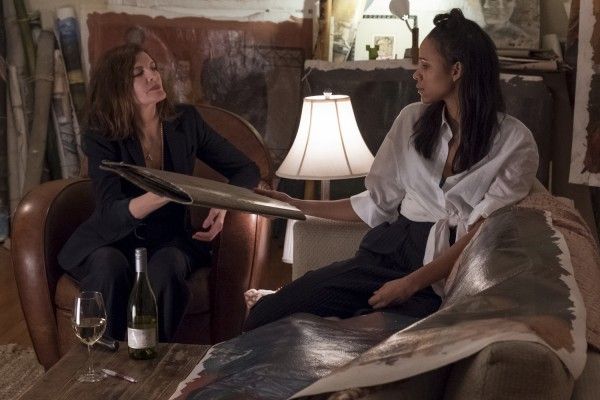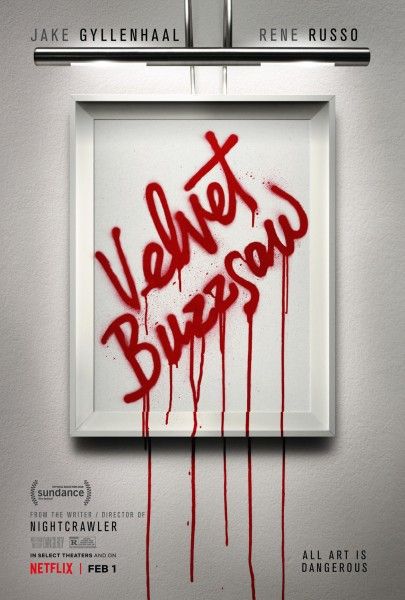[This is a repost of my review from the 2019 Sundance Film Festival. Velvet Buzzsaw is now available to watch on Netflix.]
The smartest thing writer-director Dan Gilroy does with his new movie Velvet Buzzsaw is that he keeps it light. Sure, it’s a horror movie where people die in a gruesome fashion and the subtext is how the commercialization of art by people who don’t care about art is worthy of a death sentence, but it never feels like Gilroy has an axe to grind. If this movie tried to carry itself as a highbrow critique, it would be far more difficult to appreciate Gilroy’s point of view, but because the whole film is played like a supernatural slasher, you’re always having fun while still appreciating what the film has to say.
Set in the high-end art world, the story follows a group of largely repulsive characters who don’t care about art, but deeply care about what’s bought and sold. Josephina (Hawe Ashton), who is on the outs with her boss, art dealer Rhodora Haze (Rene Russo), discovers her upstairs neighbor, Ventril Dease, dead with an apartment full of disturbing artwork, and she sees her big break. After the quality is “verified” by esteemed art critic Morf Vandewalt (Jake Gyllenhaal), who can make or break an artist with his reviews, Rhodora and Josephina team up to profit off Dease’ artwork. However, those who sell or own Dease’s artwork start to meet grisly ends as its proximity to other art causes some gruesome outcomes.
Dease’s background is pure horror pulp, the kind of story you would tell around a campfire, and Gilroy knows that he’s pitching the spookiness at an almost campy level because the “Why” of Dease is ultimately unimportant to the story. This isn’t about solving a mystery any more than a Friday the 13th movie is about solving the mystery of Jason. For Gilroy’s purposes, he’s basically made a slasher where Dease’s artwork is the monster and those that seek to profit off art while completely ignoring art’s inherent value are the hapless campers who made the mistake of having sex. For some, a critique of the art world blended with a slasher flick may be too incongruous, but it works perfectly because the movie is inviting you have fun first and then think about the subtext second.
The performances are deliciously vile with most of the characters being out for only their own ends. It’s a credit to the cast that they all lean into the venality of their characters, inviting us to despise them. As always, Gyllenhaal is magnificent, and he perfectly walks the line between Morf’s desperation and desolation. He’s a pathetic creature, but never comes off like a parody of a critic or like someone who lacks an understanding of what criticism entails. If the movie only revolved around Morf, it would be a success, but thankfully Gilroy makes use of his deep bench with Russo, Ashton, and the rest of the cast turning in compelling performances in service of the filmmaker’s vision.
When it’s time for a murder scene, Gilroy goes full horror movie. He doesn’t need to try and “elevate” the genre because he wants to make it as recognizable as possible. You can almost telegraph every beat as the victim walks all alone into an empty room, the lights are dark, something creepy is happening, and Gilroy slowly builds to the kill like any good slasher director. We recognize these beats because we recognize the genre, and Gilroy uses it to his full advantage to keep the movie funny and wonderfully macabre.
Gilroy is a veteran screenwriter and no stranger to the studio system. If he made a film that straightforwardly bemoaned those who only care about commerce and showed a completely indifference to engaging with art as art, it would come off as whiny and self-serving. By couching his critique within the framework of a slasher, Velvet Buzzsaw comes alive and allows Gilroy to take a step back, still making the most of his critiques while not being so serious that it feels like a lecture to the audience. The figures that Gilroy paints are despicable, but they’re not unrealistic, and their sin comes from being so callous towards emotion while basing their livelihoods off art that should create an emotional response.
I fear some people may come away from Velvet Buzzsaw thinking that the entire film is an indictment of all commerce as it relates to art or seeing Morf as sour grapes over critics who have panned Gilroy’s work. But Gilroy has clearly kept his critiques limited to those who step over a particular line. This is not an angry screed against trying to sell art or those who would want to critique art. The anger is directed at those who control the art world but have no love for art. I’ve seen this in the film profession. There are those who clearly have no love for movies as movies. It’s all about “The Industry” and how it functions; the art is of no importance beyond how it relates to dollars and cents.
Velvet Buzzsaw is a slasher movie with something to say. Some who stumble across it on Netflix may find it too bizarre or wonder why Gilroy is spending so much time introducing us to the cast of characters rather than getting to the murders promised in the trailer. But if you simply let the film unfold and accept it as a wild ride with some valuable insights, then Velvet Buzzsaw is a blast from start to finish.
Rating: A-





